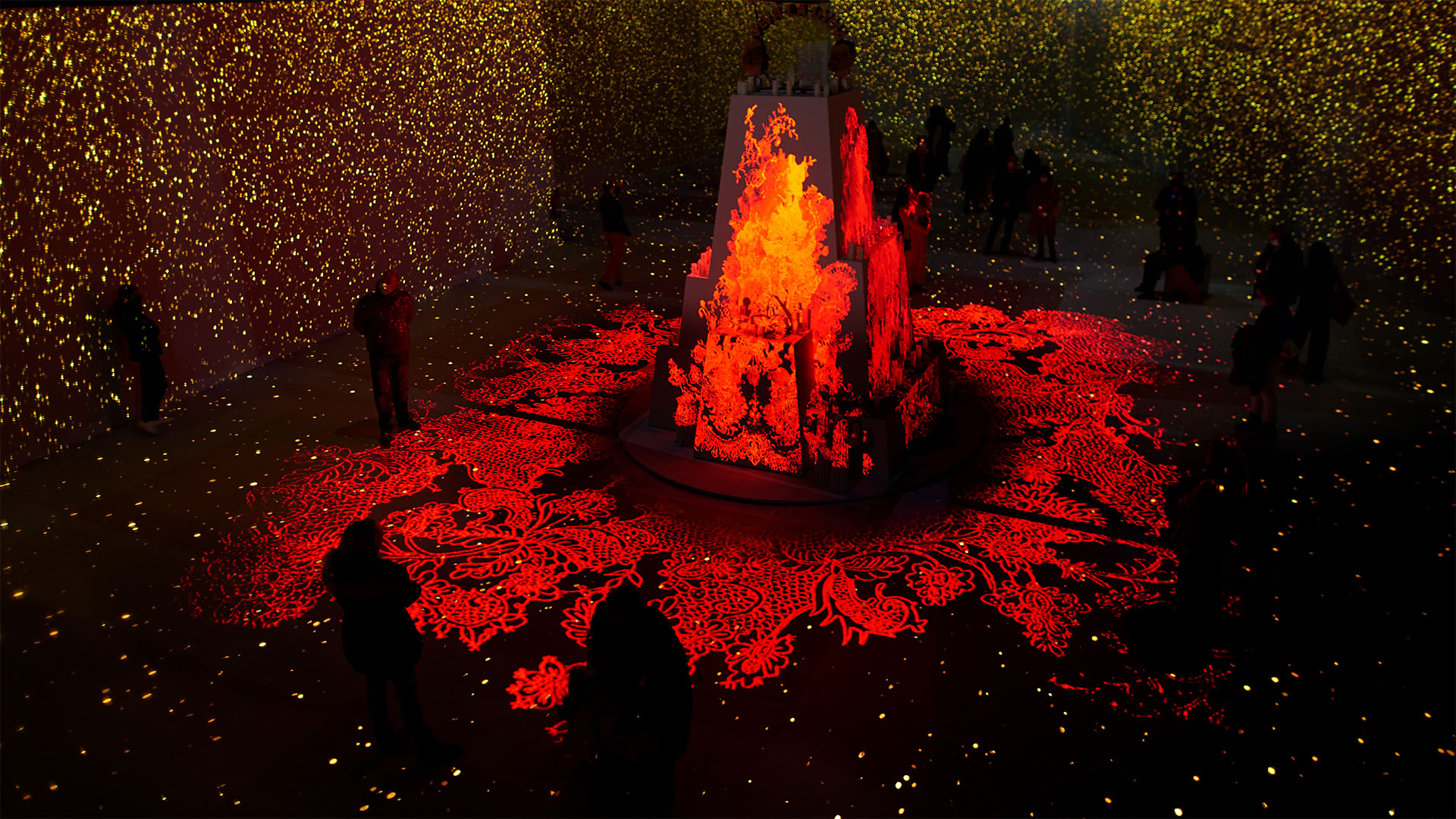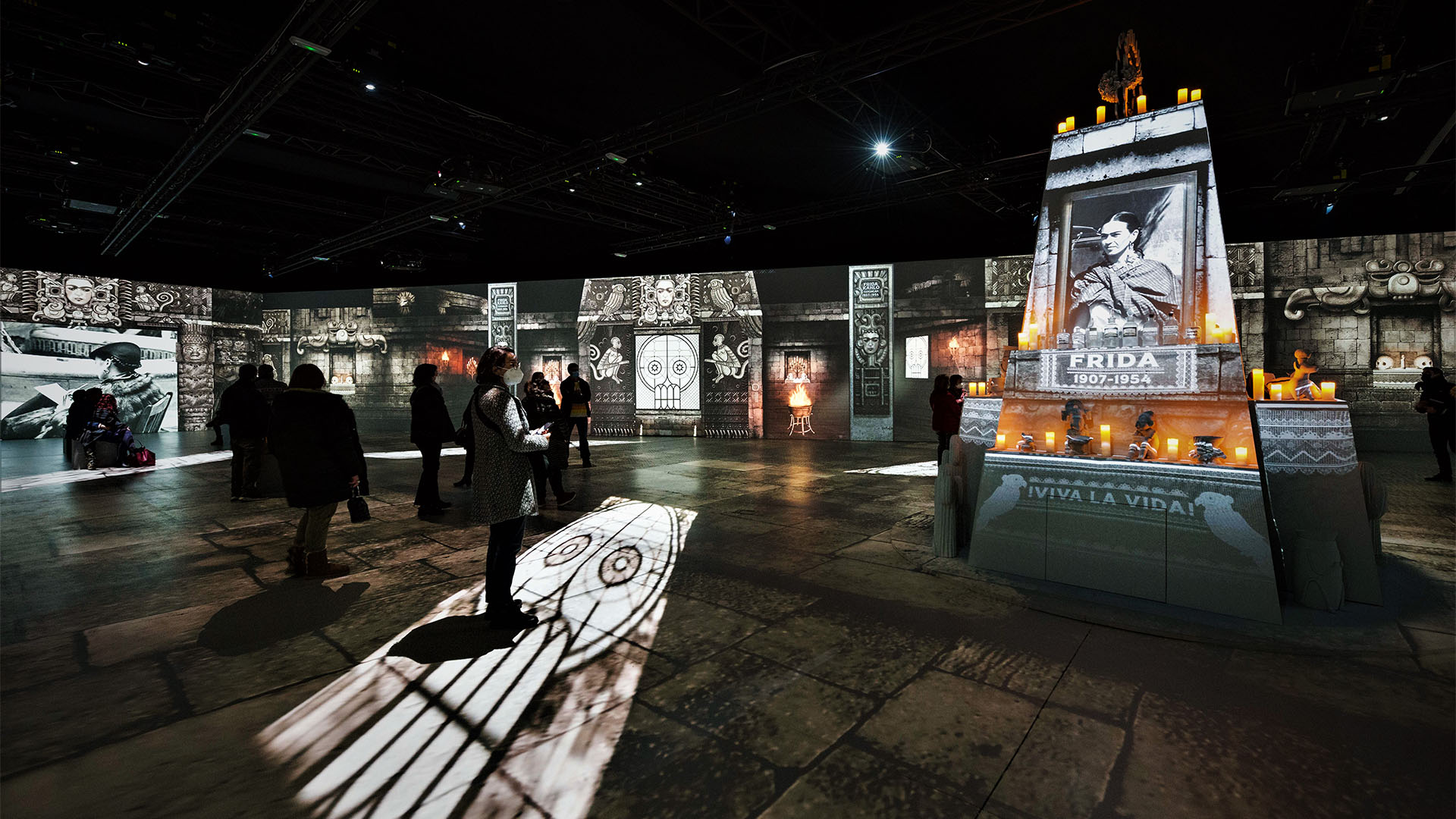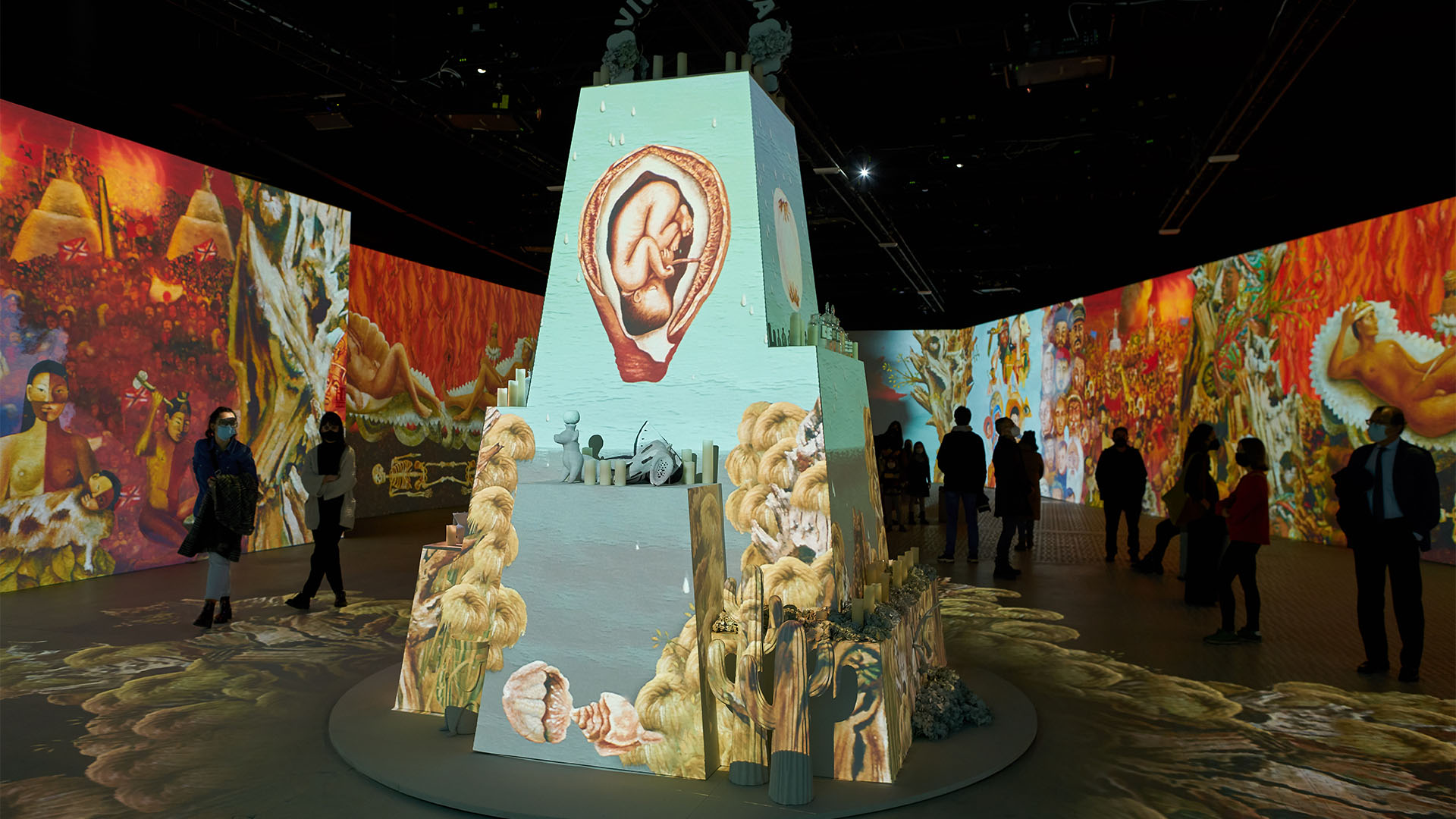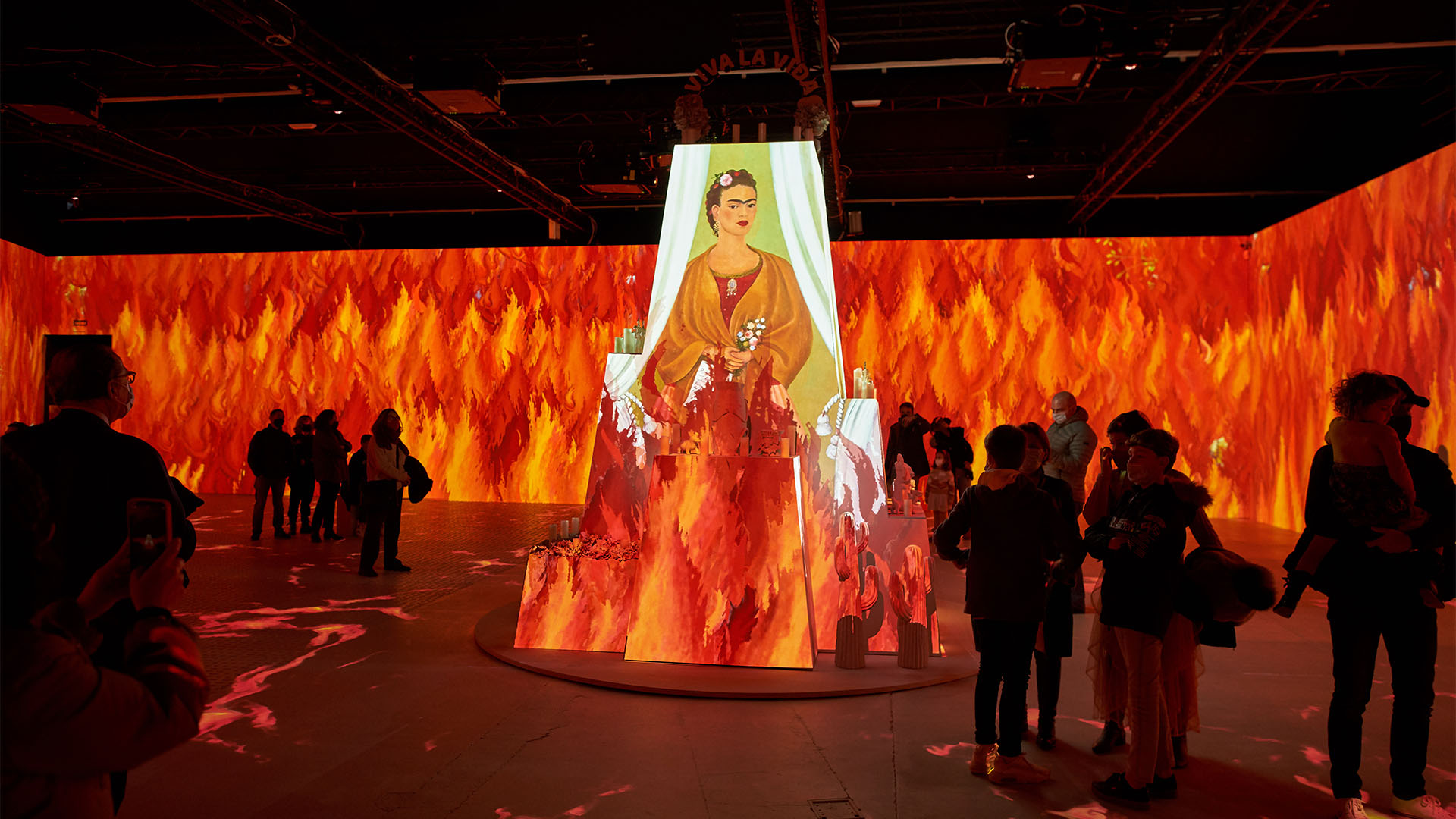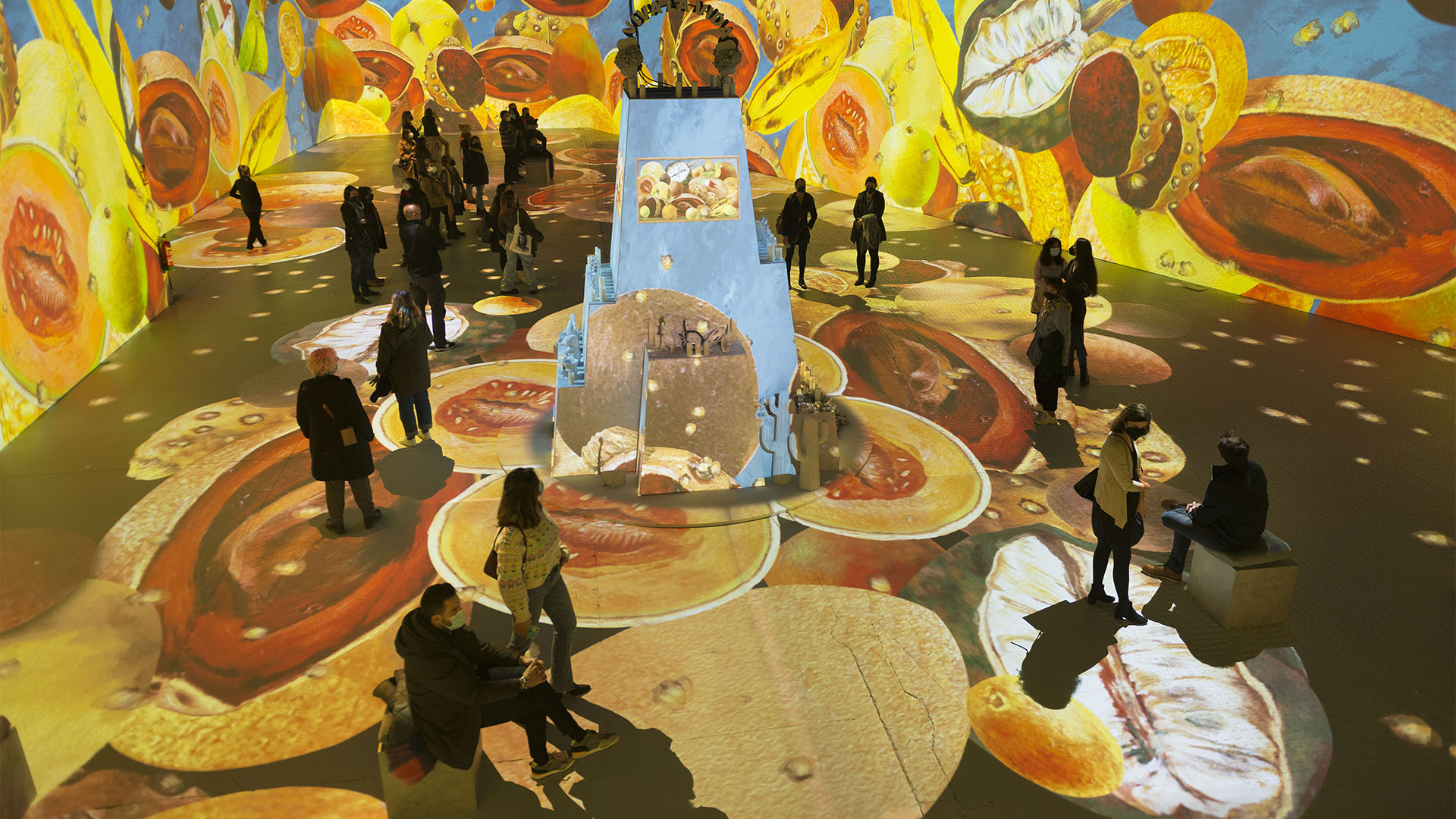Life and Work of Frida Kahlo
Life and Work of Frida Kahlo is a multisensory immersive exhibition designed, produced, and promoted by ACCIONA’s cultural management and production division ACCIONA Cultural Engineering. The exhibition combines cinematic and traditional museum experiences, featuring large-scale audiovisual elements, which set the tone for the exhibit. More than a hundred plastic artworks, literary pieces, and photographs pay tribute to the renowned Mexican painter. Displaying 2,500 hand-painted animated photograms, the exhibition brings Frida Kahlo’s masterpieces to life.
Agency
Acciona Cultural Engineering
Practice Area
Client
Acciona Cultura
Industry
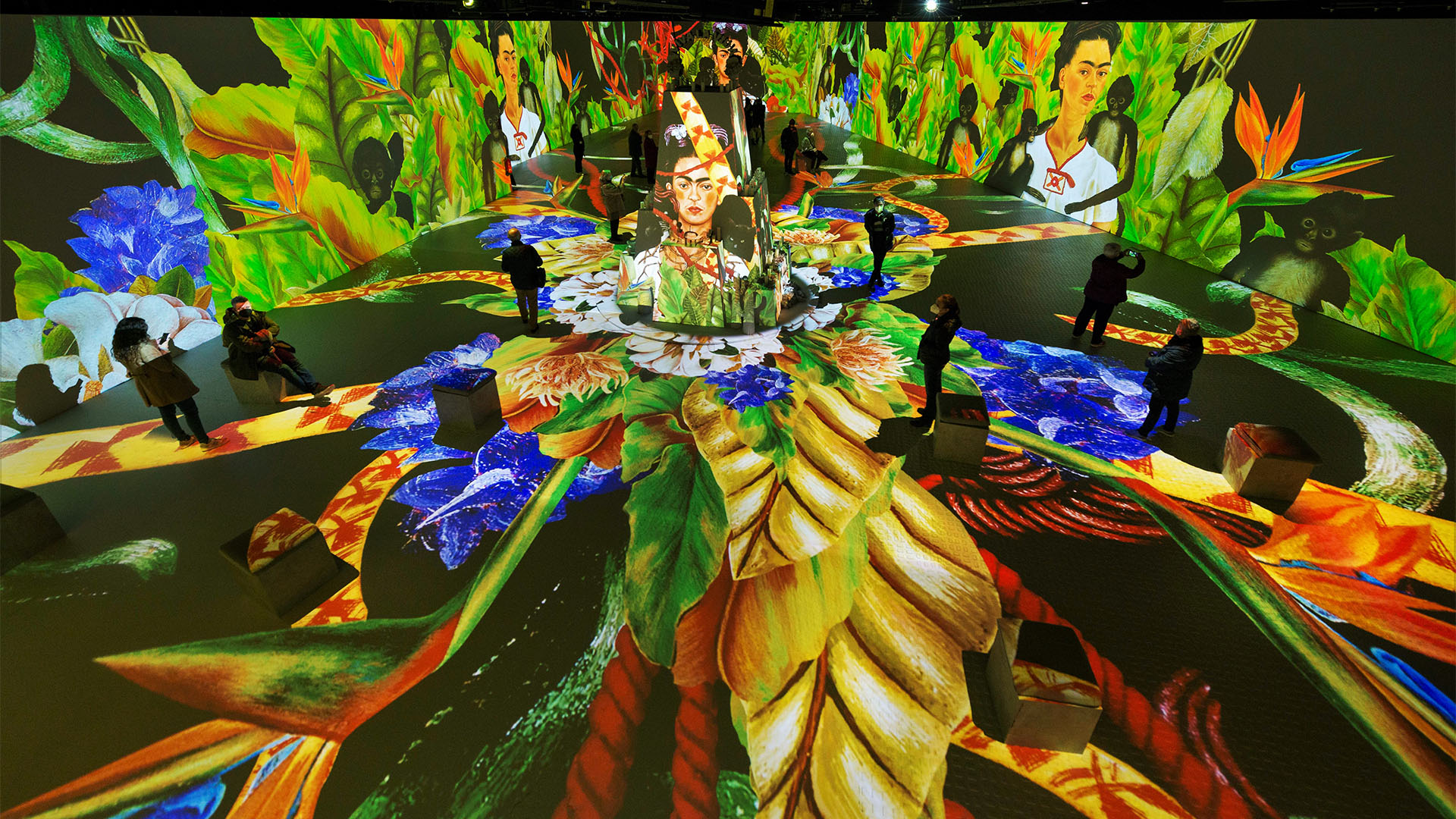
The exhibition has been created as a new approach to experiencing art. While merging state-of-the-art technology, theatrical storytelling, and world-class animation, the objective of the project was to expand the notion of what immersive art-themed light shows can be, and challenge established boundaries between contemporary digital art, academic exhibits, cinema, and experiential entertainment. We wanted to create something more than an overwhelming photo opportunity with high Instagram potential. We wanted to introduce meaningful storytelling. Not only that, but we go beyond traditional immersive exhibitions where artworks are simply projected on the wall, we have created a new innovative and visual image.
It is also a challenge to traditional artworks, which sometimes are kept in private collections or have restrictions to travel across the world, making it difficult for everyone to have access to these artworks. Our exhibition has democratized Frida Kahlo’s art, making it accessible for everyone who wants to see it and learn from it. The use of a new visual language to transmit Frida’s work has created a new experience and gone beyond boundaries. Therefore, we believe the immersive audiovisual design of Life and Work of Frida Kahlo has challenged experience design, not only for its technological innovation but also for the commitment to generating a positive social and environmental impact.
The Challenge
The principal challenge of this immersive exhibition was the narrative behind it, as we wanted to present Frida in a new and positive way, different from the cliché around her. Although Frida Kahlo is generally framed in suffering and pain, from the beginning of the project we set ourselves to show another side of her: that of a woman who faced constant hardship but managed to live her life with strength and determination. Through a narrative and audiovisual exhibition, based on her diary and testimonies of the intellectual avant-garde of her era, we present Kahlo’s intense and relatively short life and her work as an artist. Frida Kahlo is considered to be one of the most important female artists of the twentieth century, and we wanted to demonstrate how she achieved this recognition.
The narrative of Life and Work of Frida Kahlo is divided in three main acts. The first one presents Frida as a thriving and international artist, creating a parallel between her work and testimonies by her contemporaries, such as André Breton, Pablo Picasso, and Alice Rahon. The second act introduces the visitor to Frida’s most intimate side and family origins. The third and final act invites the visitor to travel to Mexico and into the Blue House, the family home where Kahlo lived, painted, and died. During the whole show, the visitor can hear two voices – one of a younger, freer Frida, and the other of an older, more experienced Frida – reading out passages of Frida’s diary. During this sensory journey through Frida’s eventful life, while listening to her deep voice, one also manages to get lost in the myriad colors of Frida’s intimate and emotional universe.
Moreover, the powerful and positive title of Frida’s last painting, VIVA LA VIDA, permeates through every scene of the exhibition, coming to a final climax at the end when the visitor can hear Frida say: “Every tick is a second of life that goes by, disappears and is never repeated. And there is so much intensity in that second, so much interest, that the only problem is to know how to live it. Let each and every one of you figure it out for yourselves! Live life to the fullest!”.
The challenge of this narrative was to achieve a positive and colorful audiovisual show to represent a lifetime of turbulent events and tragedies. It was, in the end, her strength and unique personality which made her the artist and women she become and for what she is known nowadays, and that is what stands out in Life and Work of Frida Kahlo immersive exhibition.
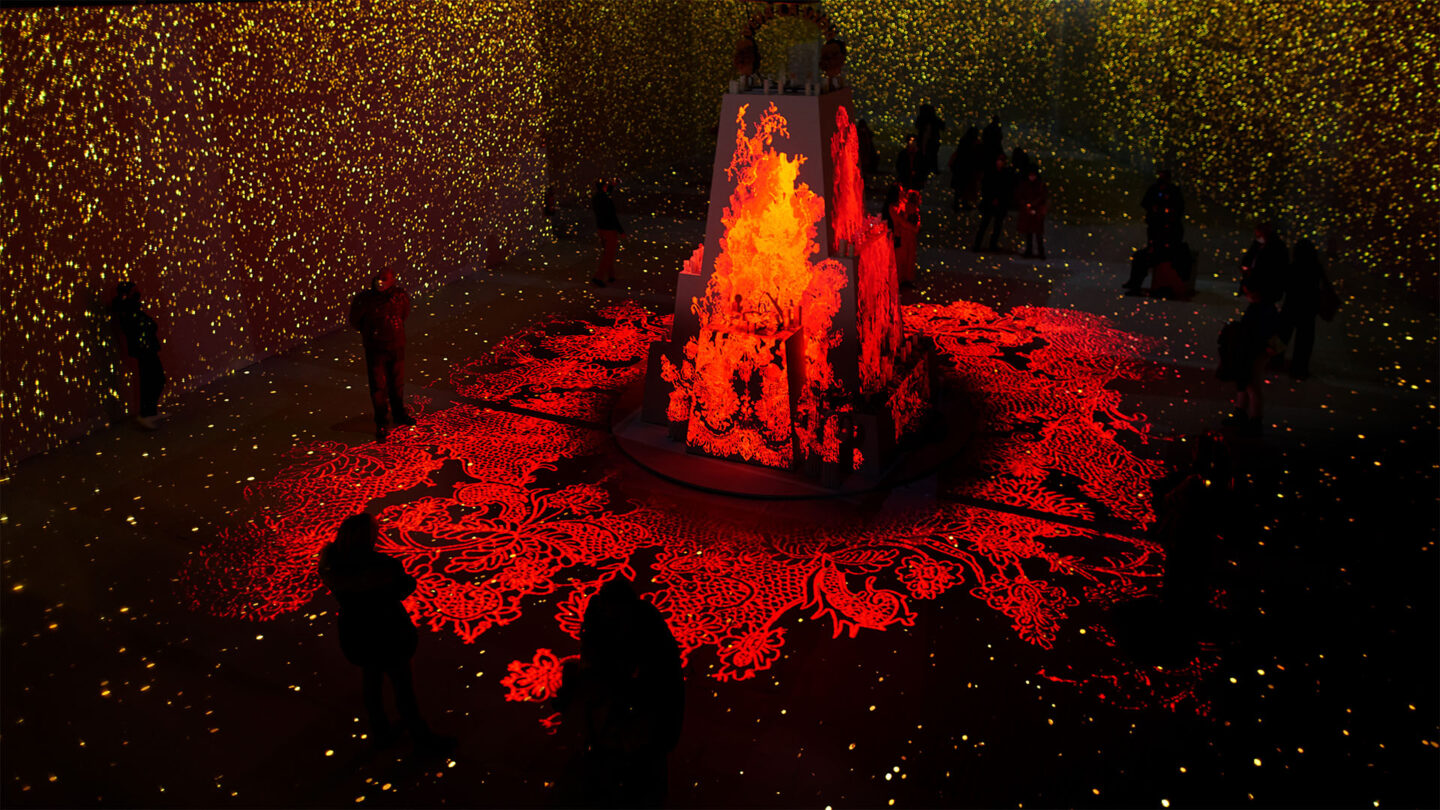
View of mapped projection on central totem element during the scene when Frida suffers her fatal accident. The red embroidery imprint represents her blood in a poetical form.
Juan Rayos
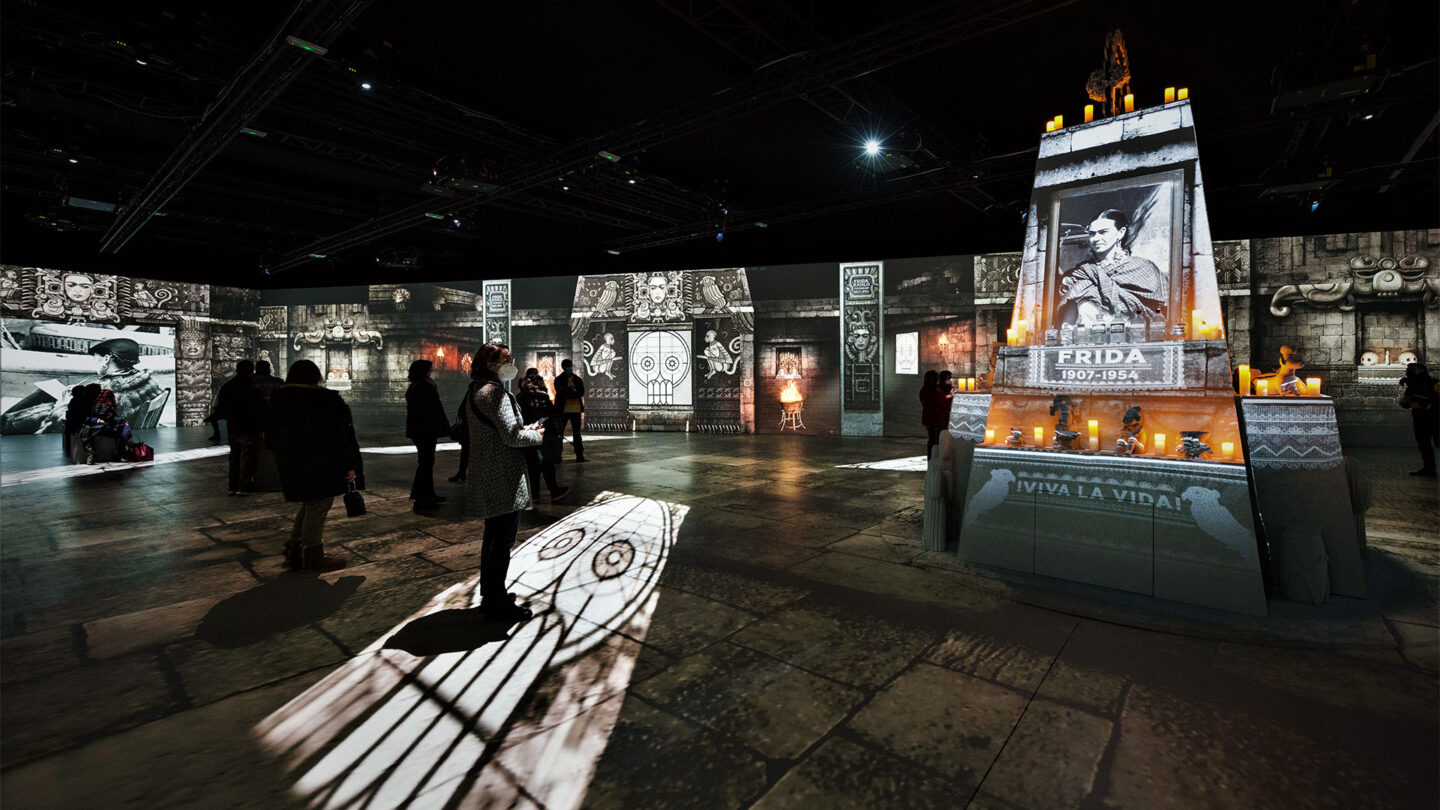
Candles on the altar light up towards the end of the show, when the story comes to Frida’s death. Visitors see Frida in real footage for the first time.
Ana Amado
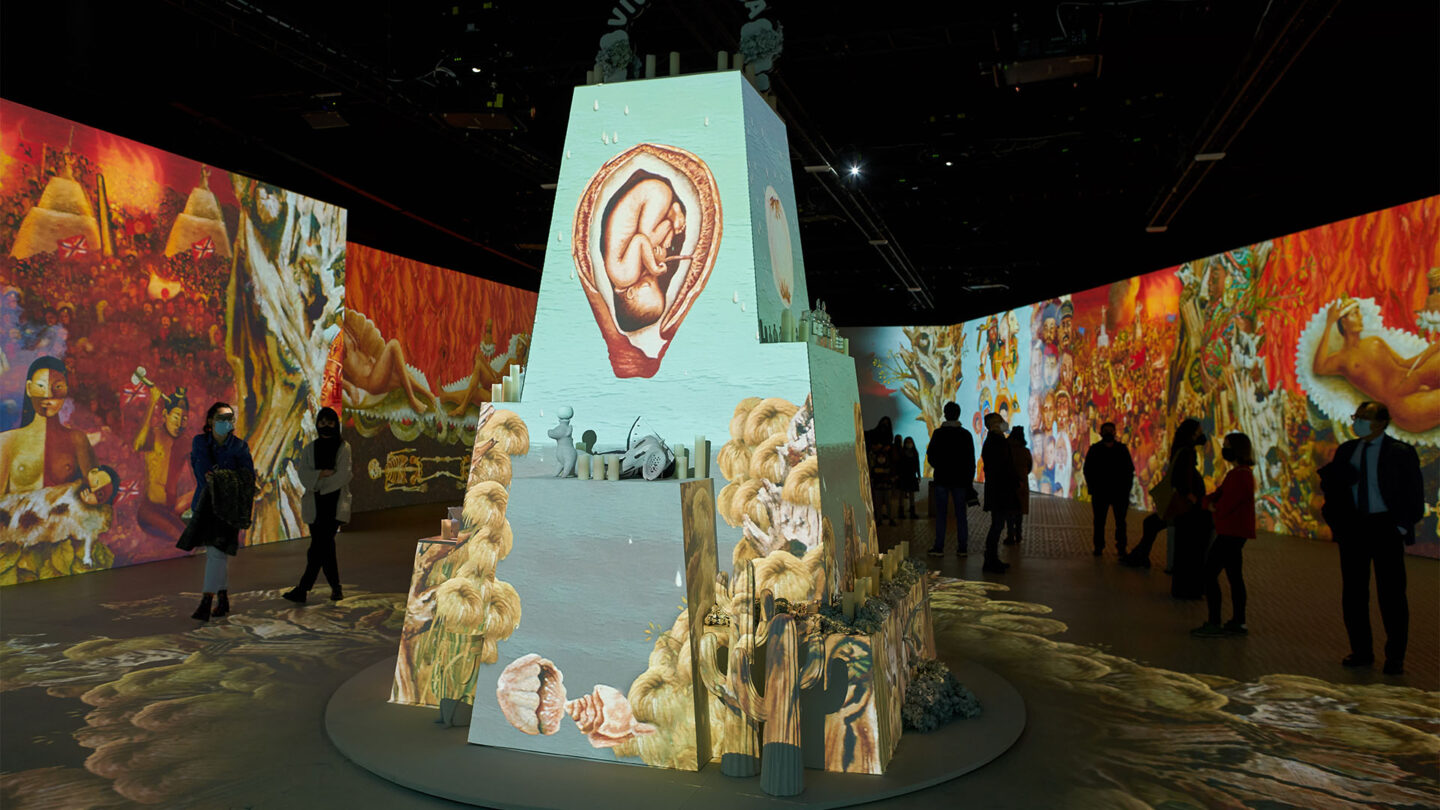
Animated characters and elements from Frida´s paintings fill the exhibition space as visitors dive into her creative universe. As if mural paintings, the artworks expand across the gallery.
Juan Rayos
Project Vision
The immersive exhibition combines cinematic and traditional museum experiences, featuring large-scale audiovisual elements to present a full of experience of the life and work of the Mexican artist. It is an exhibition based on innovation and new achievements through digital art, where the works of Frida Kahlo are exhibited all around the room, more than a hundred plastic artworks, literary pieces and photographs pay tribute to the renown Mexican painter. Displaying 2,500 hand-painted animated photograms, the exhibition brings Frida Kahlo’s masterpieces to life.
Immersive art exhibitions are becoming more and more common nowadays, and it is a reality that technology has allowed us to express and exhibit art by any artist in a new language. Even though it might be seen as a trend, this project is a combination of elements which make it unique and innovative in comparison to others. The immersive audiovisual interprets and delves into Frida Kahlo’s paintings to understand her life and work. The exhibition is perceived through a narrative storytelling based on the artist’s testimony from her diary. Also, there is an original soundtrack created specific for the exhibition by the Goya nominated composer Arturo Cardelús, inspired on Frida’s European and Mexican origins, which embellishes the narrative. There has been a strong commitment with the quality of the projections to achieve a unique immersive experience. TIGRE Lab studio, a team of graphic designers and content creators, have worked to design an audiovisual storytelling using more than a hundred plastic artworks, literary pieces and photographs from the artist’s state. While merging state-of-the-art technology, theatrical storytelling, and world-class animation, the objective of the project was to expand the notion of what immersive art-themed light shows can be, and challenge established boundaries between contemporary digital art, academic exhibits, cinema, and experiential entertainment. We wanted to create something more than an overwhelming photo opportunity with high Instagram potential. We wanted to introduce meaningful storytelling.
Design + Execution
Life and Work of Frida Kahlo is exhibited in a venue in Madrid, in the Argensola district, which used to be an old bus depot. The space has been rehabilitated and repurposed from its original architectural meaning to be adapted for an immersive exhibition, which boasts 1,129 m2 of 4K projection surface (including walls and floors) and 38 state-of-the-art projectors. The structure of the old bus depot has maintained mostly the same, with an underground look to be as neutral as possible as a contrast to Frida Kahlo’s art.
The project was design by a collaboration of different teams of content creators, graphic designers, sound makers and music composers which, thanks to a combination of their excellent and hard work, have achieved an audiovisual experience exhibition about the life and work of the most renowned Mexican artist of all times. Moreover, the audiovisual has been designed to be adapted an exhibited in different spaces, as the objective of this project is to make it itinerate around the globe. Therefore, the venue where it is being exhibited in Madrid has standard architectural facilities. The establishment was rehabilitated from an industrial space, and it has maintained its original structure and essence, with wide and tall walls, lack of columns and an industrial flat floor. The color palette used in the entire space has been designed to be as neutral as possible, to contrast with Frida Kahlo’s colorful work. Also, the scale of greys used at the corridors and complimentary spaces of the exhibition were designed to represent the lights and shadows in Kahlo’s life and, as well, to refer to the iconic “Casa Azul” in Mexico, where Frida lived and worked. The decorative inspiration of the space is based in Mexico but fleeing away from the cliché of the Mexican culture. Other elements in the space, such as the shop, have contributed to this design intent, as it is intended to be a continuation of the exhibition, where the objects for sale have been located as exhibiting Mexican pieces, with an illumination nearly museum-like.

View of exhibition space. The room sets on fire under and around visitors. This scene follows a
verbal encounter between Trotsky and Frida. It refers to her revolutionary spirit.
Juan Rayos
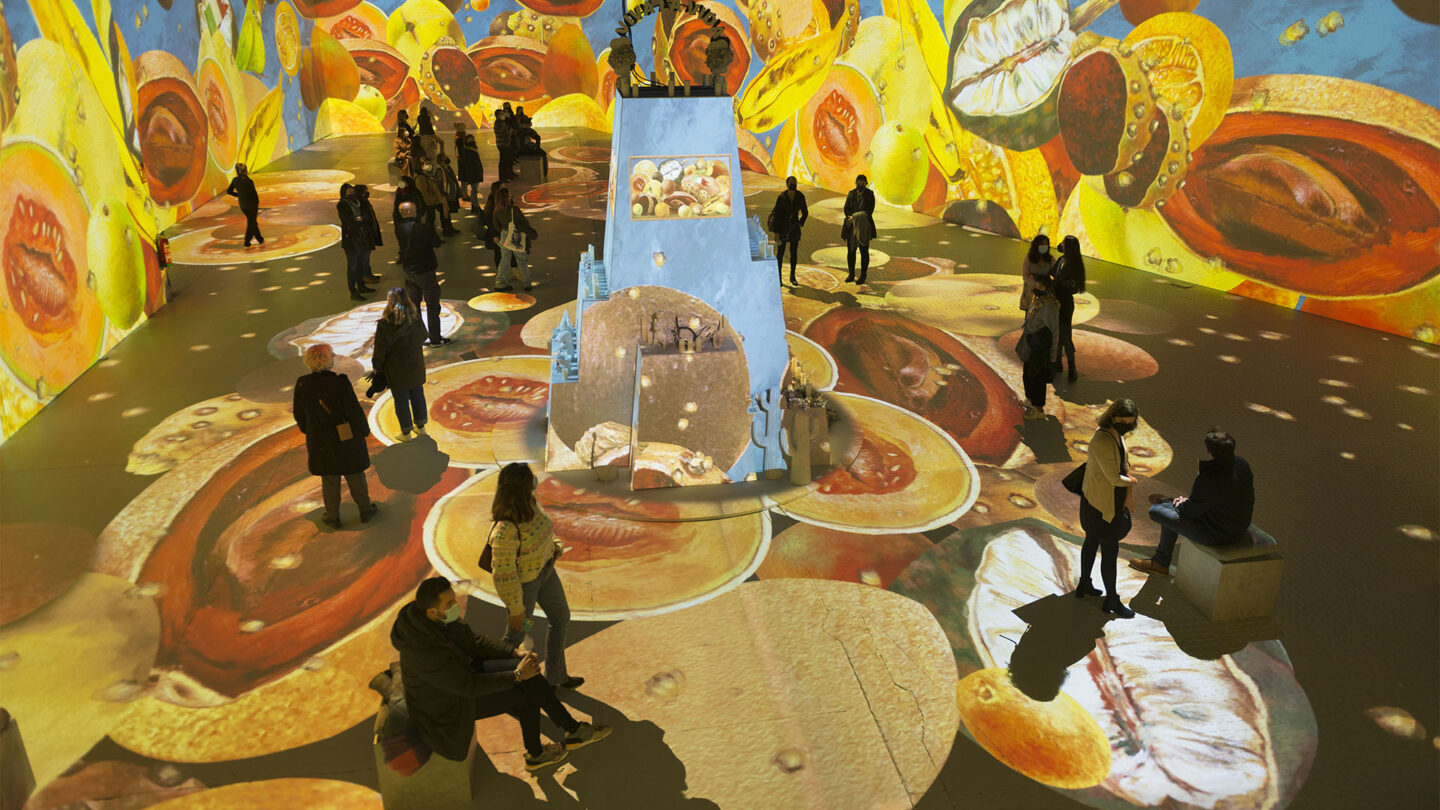
This scene refers to one of Frida’s favorite themes: still lifes. She found amusement in anthropomorphizing fruits, as well as finding erotic similarities in their forms.
Ana Amado
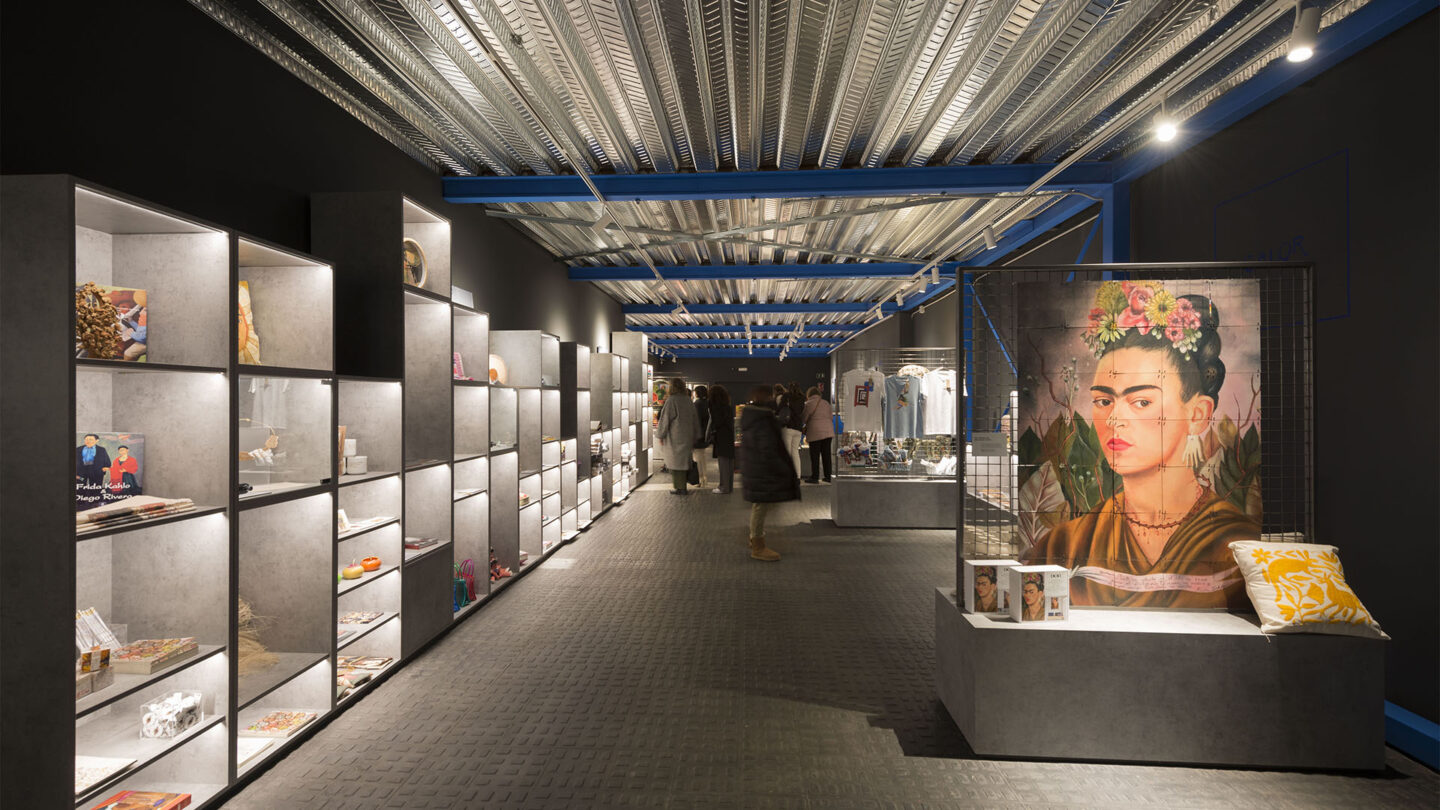
The exhibition shop is inspired by the colors of Frida’s house in Coyoacan. Mainly grey, blue, dark green, and red. The store sells merchandising and Mexican artisan products.
Ana Amado
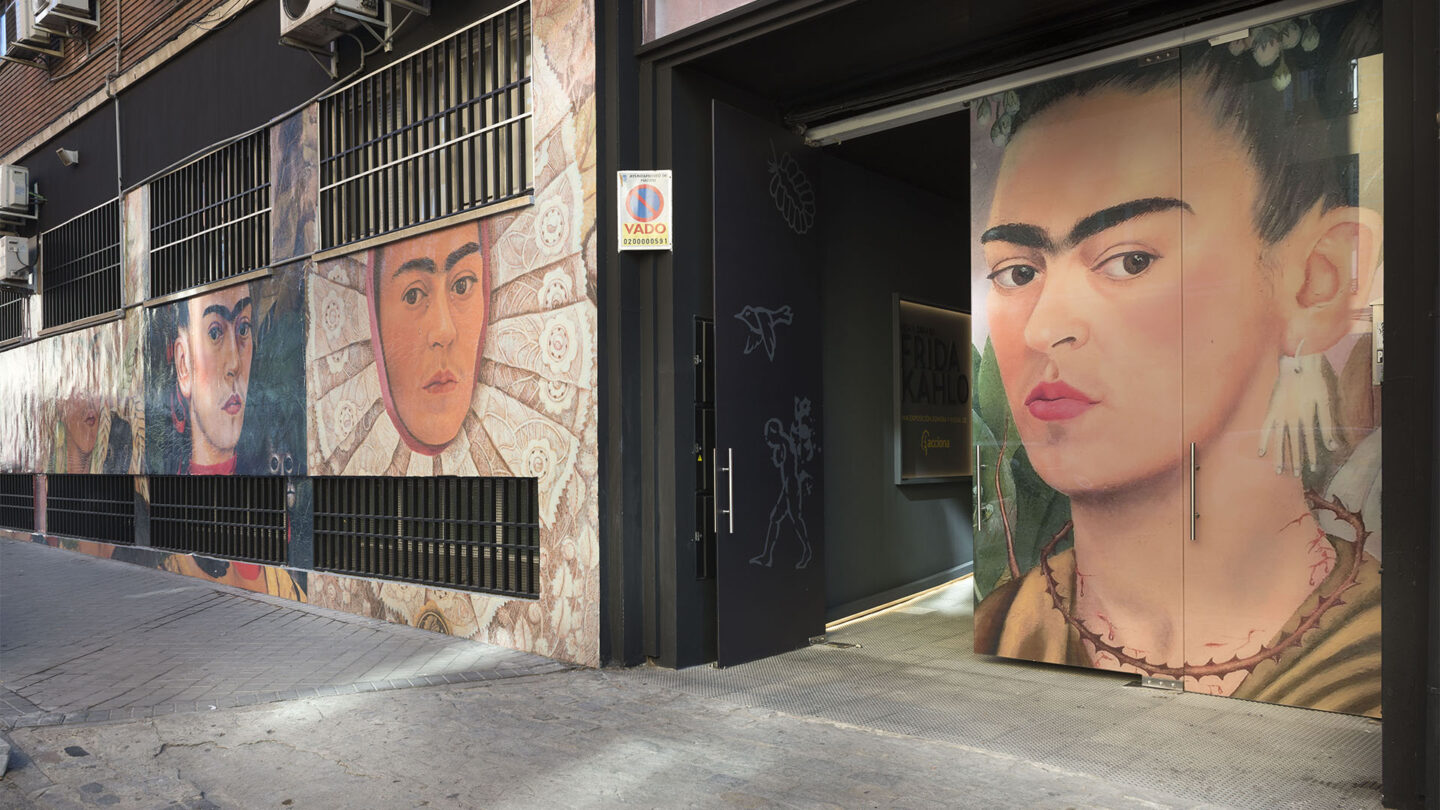
Exhibition facade, 5 images of Frida’s self set the mood of the visitor.
Ana Amado
Project Details
Design Team
Clotilde Entrecanales (project director), Carla Prat (artistic director), Mathieux Felix (audiovisual director), Arturo Cardelús (soundtrack composer), Paula Peña (graphic’s manager), Steve Miller (sound designer), Roxana Velasquez, Deidré Guevara (curators)
Photo Credits
Ana Amado and Juan Rayos (photography)
Frida’s IP: Bank of Mexico, Diego Rivera and Frida Kahlo Museum Trust
Juan Rayos (videography)
Open Date
December 2021
